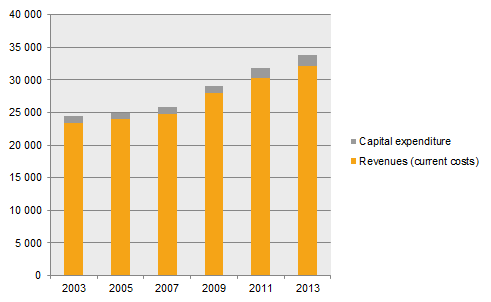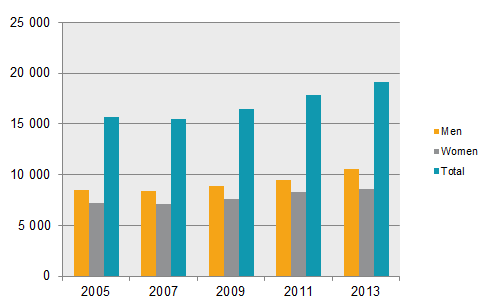Increased funding for R&D in the higher education sector 2013:
Increased funding for R&D in the higher education sector
Statistical news from Statistics Sweden 2014-12-17 9.30
Funding for research and development (R&D) in the higher education sector continued to rise in 2013 compared to previous surveys. R&D expenditure amounted to SEK 33.8 billion in 2013, an increase of SEK 1.9 billion. The number of person years for R&D, primarily for doctoral candidates, also saw increases in 2013.
R&D expenditure in the higher education sector amounted to SEK 33.8 billion in 2013, an increase of SEK 1.9 billion from 2011. R&D expenditure is made up of current costs1 (revenue) and capital expenditure. R&D revenue saw an increase of SEK 1.9 billion while investments increased by SEK 42 million.
1 R&D operating costs are estimated using data on R&D revenue and depreciation. Total R&D expenditure consists of operating costs and investments.

The increases in revenue for R&D between 2011 and 2013 were largely due to increases in government appropriations. Block grants and other grants have seen a combined increase of SEK 570 million. Funding from the Swedish Research Council and private non-profit organisations has also increased by SEK 501 million and SEK 350 million, respectively.
Increased number of person-years by doctoral candidates
Just as economic resources available for R&D have increased, so have the number of person years for R&D increased in recently years. The number of person-years2 for R&D carried out by employees in the higher education sector amounted to 19 104 in 2013 which is an increase of 1 295 person years compared to 2011. Men performed 55 percent of these person years while women accounted for 45 percent.
2Non-employees includes doctoral students who are not employed, as well as other researchers and teaching staff who are not employed.

Doctoral candidates accounted for a large part of the increase in person-years for R&D. The number of person-years increased to 6 989, up 1 012 from 2011. The number of person-years in the researcher and lecturer category has also increased while research assistants and administrative and other technical personnel have decreased. Person-years for non-employees3 accounted for approximately 1 900 in 2013.
R&D activity in different research areas
Natural science and medicine are the largest research areas for R&D both in terms of revenue and expenditure. Similarly, it is these two research areas that have seen the largest increases in R&D expenditure between 2011 and 2013. Expenditure for natural science increased 12 percent while for medicine and health science the increase was 10 percent. The greatest decrease occurred within agricultural science where expenditure for R&D is 5 percent lower.
3 Non-employees includes doctoral students who are not employed, as well as other researchers and teaching staff who are not employed.
Definitions and explanations
Scope of the survey
The survey includes R&D activities at universities and institutes of higher education. It is conducted every other year and includes about 44 universities and institutes of higher education.
Research: systematic work to find new knowledge or ideas with or without the aim of a particular purpose.
Development: systematic work that uses research results, scientific knowledge or new ideas to bring about new material, goods, services, processes, systems, methods or significant improvements of those that already exist.
Feel free to use the facts from this statistical news but remember to state Source: Statistics Sweden.
